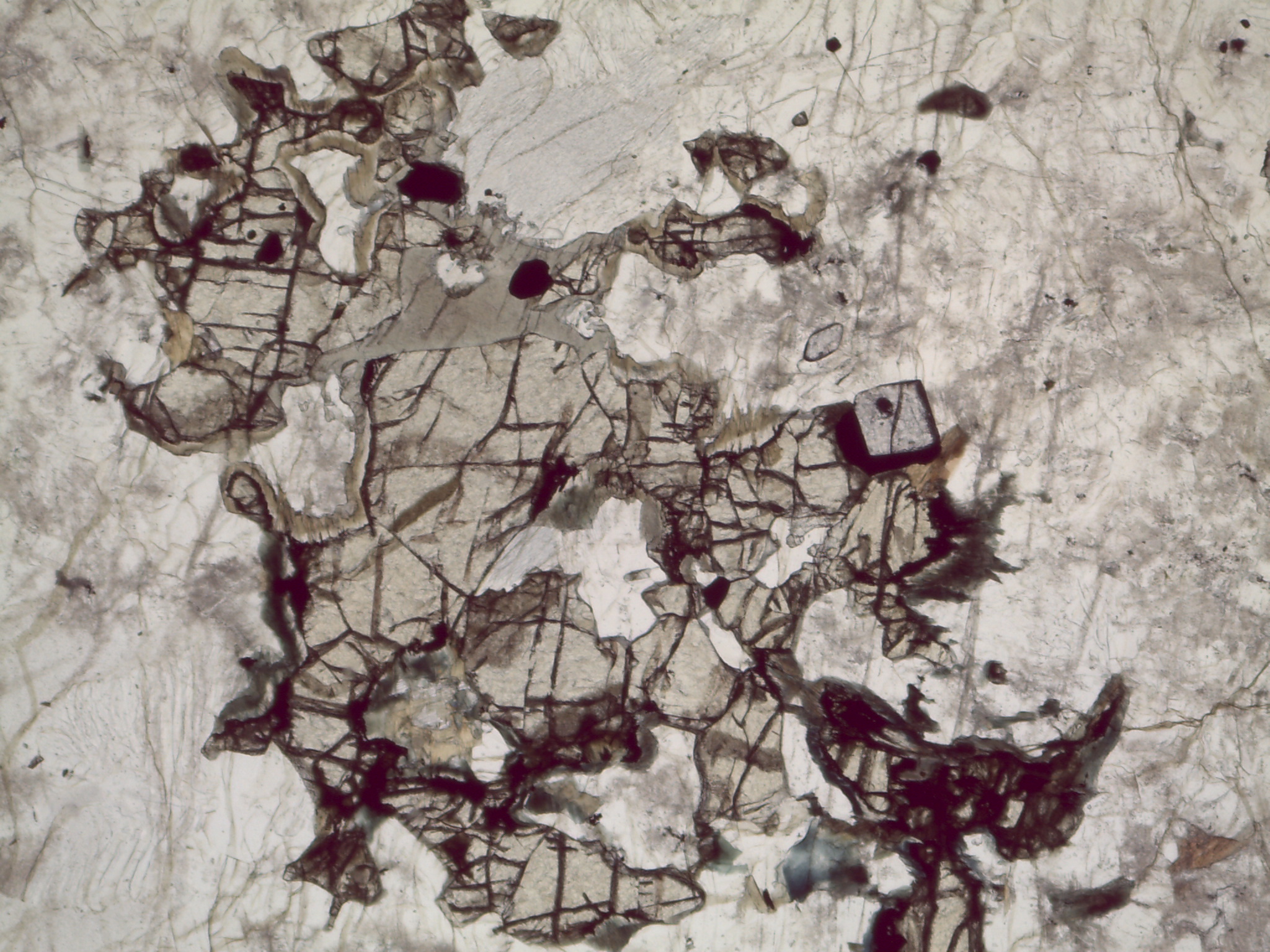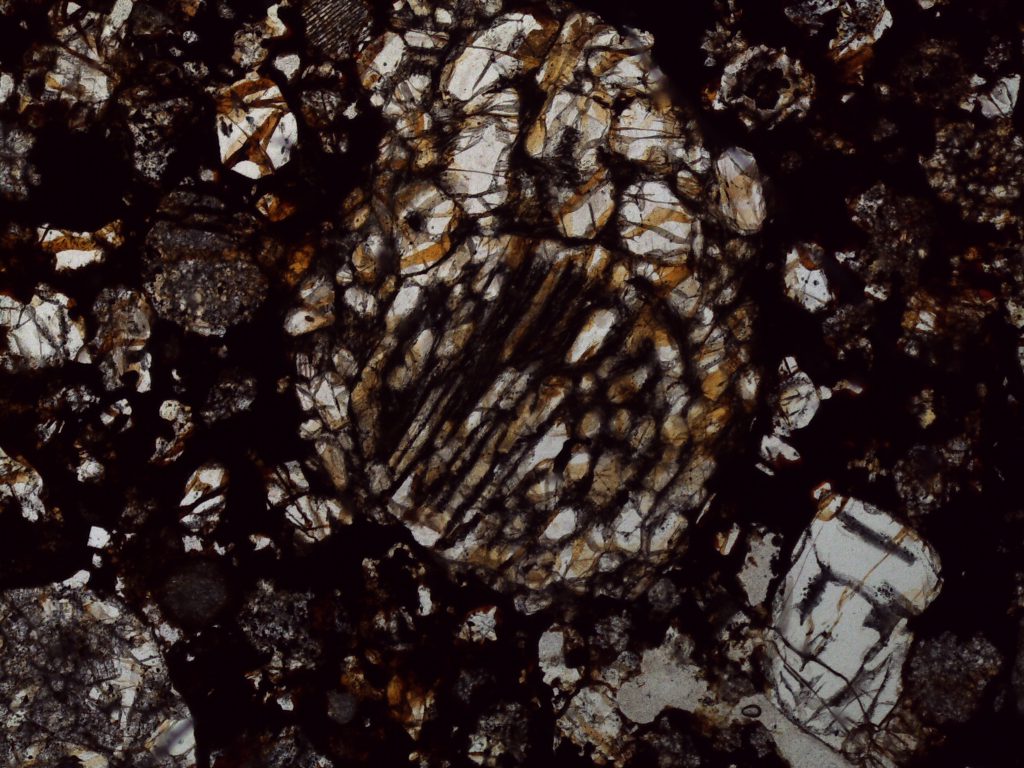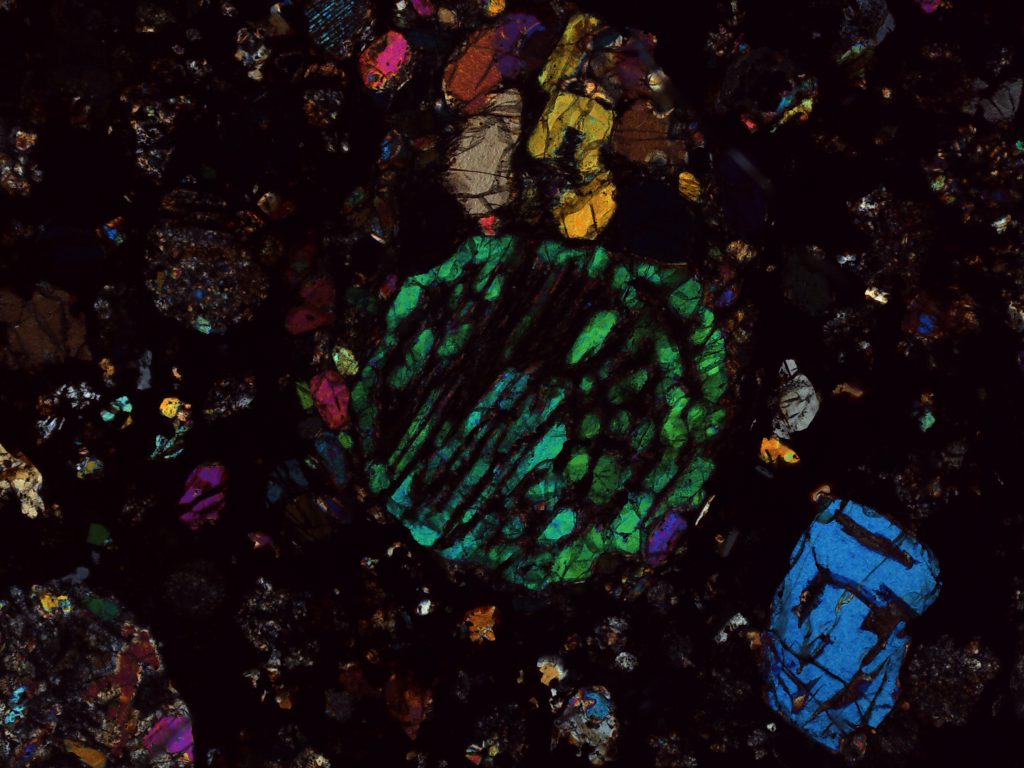Olivine is a solid solution series mineral whose two most common end members are forsterite (Mg) and fayalite (Fe). This page concerns itself with olivine in general. If you need end member-specific information, please see the forsterite and fayalite pages.
Physical Properties |
|
| Chemical formula | (Mg,Fe,Mn)SiO4 |
| Class | Nesosilicate Isolated tetrahedra |
| Crystal system | Orthorhombic |
| Habit | Granular Prisms Dipyramids Tabular Crystals large enough to display a distinct habit are rare. Olivine is more commonly found as small rounded or embedded grains. |
| Color | Green Yellow Colorless |
| Hardness | 6.5 |
| Specific gravity | 3.2 (forsterite) 4.4 (fayalite) |
| Cleavage | Poor (010) and (100) |
| Fracture | Conchoidal |
| Luster | Vitreous |
| Transparency | Transparent to translucent |
| Streak | White (forsterite) White-yellow (fayalite) |
Optical Properties |
|
| PPL | High relief Fractured appearance Colorless (forsterite) Pale yellow or green, and may be weakly pleochroic (fayalite) |
| XPL | High relief High 3rd order colors Fractures and high birefringence combine to make a “stained glass” appearance |
| δ | 0.035 (forsterite) 0.053 (fayalite) |
| after Perkins, 340-342 |
Olivine in Hand Sample
Magnetite with fayalite
Olivine filling the vesicles in a porphyritic vesicular basalt from Hawaii
Olivine sand from Hawaii
Olivine in Stillwater Complex chromite olivine cumulate
Olivine in a mantle xenolith, or “xenobomb”, from Kilbourne Hole in New Mexico
Olivine in another xenobomb
Scanning electron micrograph of olivine
Xenobombs are pretty great. If you’d like to learn a little more about them, scroll down to the Bonus Content section at the bottom of this page.
Kilbourne Hole, where both of the xenobombs featured here were collected, is also pretty great. Space exploration enthusiasts should absolutely scroll to the Bonus Content section at the bottom of this page to learn about NASA using Kilbourne Hole as an Apollo training site and modern equipment testing site.
Olivine in Thin Section
Thin Section GigaPans
Olivine in gabbro, plane polars
Olivine in gabbro, crossed polars
Olivine in lunar basalt sample 12002, plane polars
Olivine in lunar basalt sample 12002. crossed polars
Olivine in lunar basalt sample 12005, plane polars
Olivine in lunar basalt sample 12005, crossed polars
The lunar samples were imaged by, and are used with the permission of, Paul Karabinos. NASA has brief but full descriptions of 12002 here and 12005 here. The Lunar and Planetary Institute hosts dozens of documentation photos of 12002 here and 12005 here, including photos of the hand samples from which they were cut.

Olivine, PPL


This is a barred olivine chondrule from the Cole Creek meteorite, an ordinary chondrite found in Nebraska in 1991.


Further Reading
Olivine at webmineral.com
Olivine at mindat.org
Bonus Content
Xenobombs
The New Mexico Bureau of Geology and and Mineral Resources has published an excellent overview of the geologic setting and features of Kilbourne Hole.
Callan Bentley is (rightly) rather taken with xenobombs, and has published three blog posts about them. You can read them here, here, and here.
NASA at Kilbourne Hole
Kilbourne Hole served as a training site for Apollo astronauts whose missions included geologic sampling on the moon. William C. Phinney coordinated the Apollo astronauts’ science training. His 330-page Science Training History of the Apollo Astronauts is available online, and talks about their training at Kilbourne Hole in some detail.
These days, NASA and others are using Kilbourne Hole to test equipment and methods which might someday be used on other solar system bodies. This Notes from the Field blog post from NASA Earth Observatory discusses the technologies they’re testing at Kilbourne Hole. The video toward the end is particularly informative.
The Footsteps of Apollo Astronauts, another blog post from NASA Earth Observatory, features geologist and Apollo 17 astronaut Jack Schmitt. As of 2020, Schmitt remains the only professional scientist to have set foot on another solar system body. He collected Troctolite 76535, the most interesting sample returned from the moon. (There’s actually very little about Kilbourne Hole in any of these links, but your friendly author’s fellow space exploration nerds enthusiasts know how it is–you find one thing, and then other things, and then you want to share all the things with all the people. There’s a picture of Troctolite 76535, at least, and it’s studded with olivine, so the argument can be made that it still belongs on this page.)